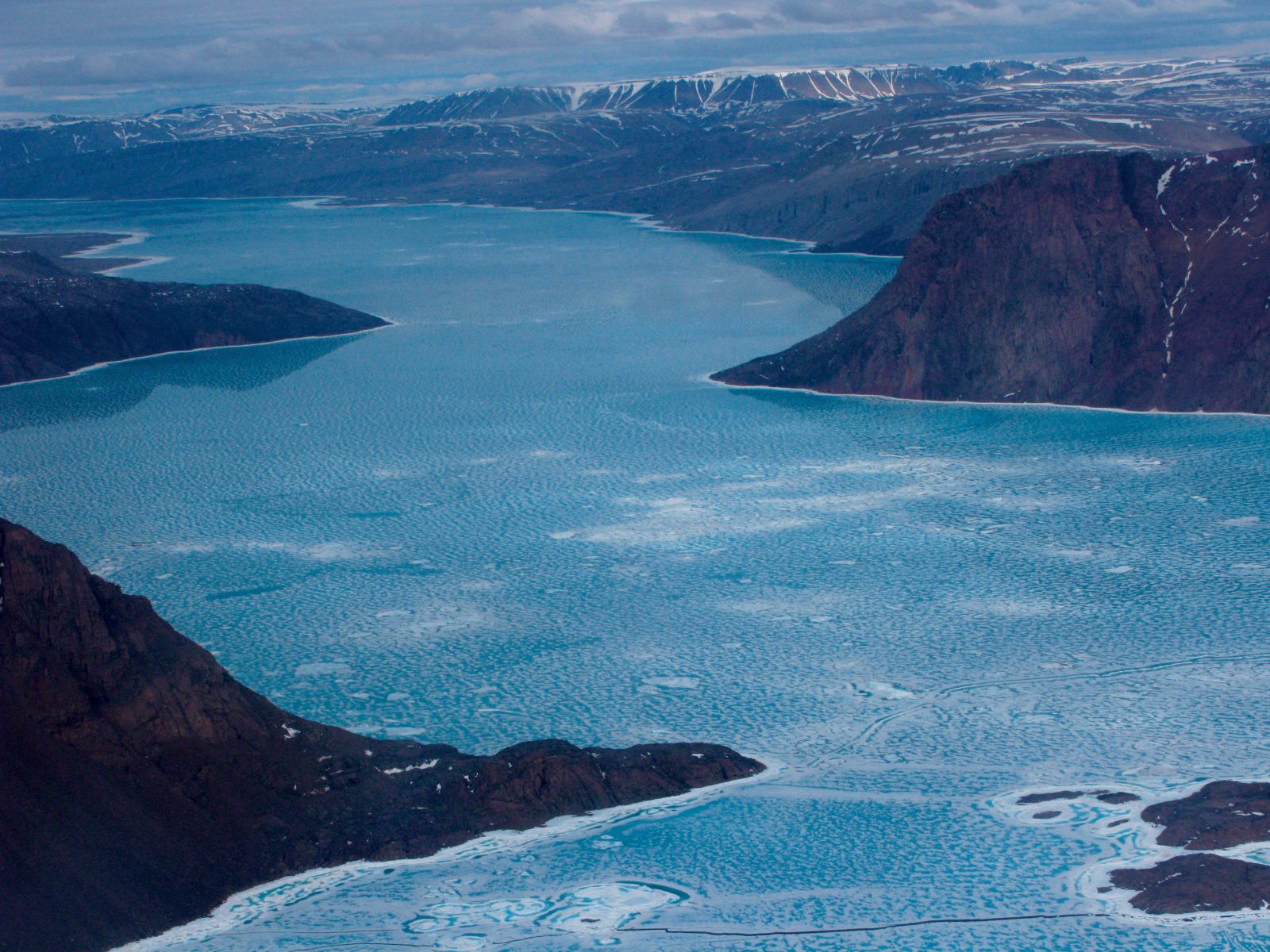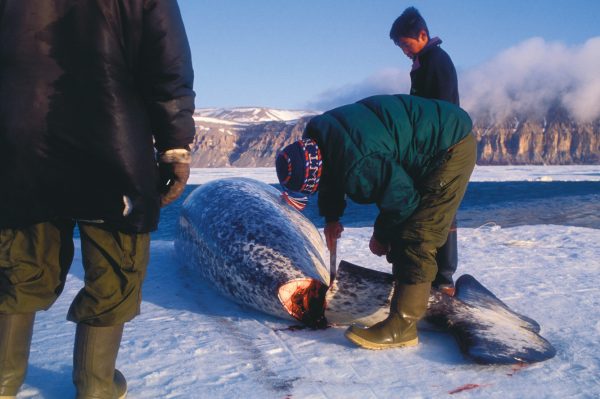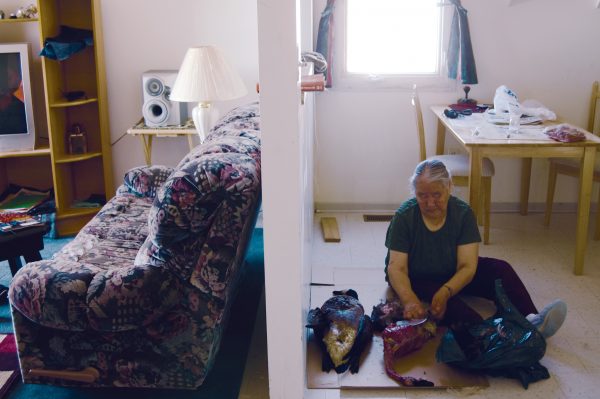
Land of the Midnight Sun
The Inuit who settled Grise Fiord were masters of adaptation. Now the changing climate is forcing Inuit to adapt once again.
Grise Fiord, population 148, is Canada’s northernmost community. It was settled in 1953, one of 25 Inuit communities established by Canada’s federal government during the Cold War to assert its ownership of the Arctic islands. A handful of Inuit families from northern Quebec and Baffin Island—poverty-stricken and internally displaced when the fox fur trade collapsed in the 1950s—were installed on the southern shore of Ellesmere Island to fly the maple leaf over the 2,000,000 sq km territory of Nunavut in Canada’s eastern Arctic. But at 81º north, it was colder and farther north than any of them had ever been, and they were surrounded by an alien terrain and unfamiliar wildlife. Most had never experienced 24-hour darkness or seen a muskox before. They were ill-equipped for what is some of the harshest terrain humans have continuously inhabited. They often starved.
The consequences of this wholesale cultural shift are well-documented and long-lived: violent crime and suicide rates are climbing; life expectancy is falling. A Royal Commission on Aboriginal Peoples described it as “one of the worst human rights violations in the history of Canada”.
But the Inuit made a life here: they adapted to a new climate and a new environment, re-built their sleds, made huts from scrap wood and learnt the migration route of the belugas, eventually becoming effective hunters.
In the beginning they called it Ausuittuq, “the place that never melts”. But “never” proved to be a very short time. The vast landscape of ice is now becoming warmer, softer and unpredictable in a changing climate.
The ice on which the Inuit depend for hunting is breaking beneath their feet and the rules of the game have changed once again. “It’s the very thing we’re going to need as we go into the second wave of change,” says Sheila Watt-Cloutier, who was nominated for a Nobel Prize last year for decrying the impact of global warming on her people and their environment. “It’s ironic, the very thing we’re reaching out to is under threat.”
These Inuit, who have already endured so much dislocation, now also seem to be the first victims of a changing climate, and for the second time in a single generation they must adapt to a radically new environment.
[chapter break]
“You Lean When I Lean,” yells Marty Kuluguktuk over the engine’s shrieking. We’re careening sideways on a snowmobile around boulders and frozen tundra, approaching the foot of a glacier just east of Grise Fiord. Bare-faced in the cutting May wind, Kuluguktuk is aware of only two positions on the throttle: full and idle.
Halfway up the glacier’s smooth white tongue, Kuluguktuk pulls over to a pair of aluminium poles poking out of the ice and cuts the engine. One of the poles is attached to a white metal box and a solar panel—a remote weather monitor. “This is where we measure the glacier,” says Kuluguktuk, Grise Fiord’s acting senior administrative officer. “Last year, it shrank 1.5 metres.” We continue northward up the slope, turn sharply at the top and head south along a rocky ridge dusted with snow. He points to a hill leading to town. “That was all glacier just 10 years ago,” he says. “It’s gone.”
The glacier is Grise Fiord’s main water supply. Fragmentation is accelerating its retreat into the hills, and last summer, the run-off didn’t fill the reservoir. In spring, when the hamlet ran out of water, officials dispatched a front-loader to chip chunks off an iceberg locked in sea ice just offshore.


A tottering scramble over jutting rocks leads to a stone cairn on the edge of a cliff—a sturdy sentry over Jones Sound and distant Devon Island. Mountains separate Ellesmere’s southern fiords like talons. The air is cool and moist, and the evening’s 24-hour sun glows through a gauzy haze. Directly below us is Grise Fiord, a cluster of dots tangled in a spider-web of snowmobile trails.
Unlike Nunavut’s capital, Iqaluit, with its cappuccinos and racquetball, Grise Fiord, the territory’s second-smallest community, is traditional and family-oriented. There are about 40 dwellings and another 20 public and commercial buildings. Everyone hunts or knows someone who does. Many rely on seal, beluga, narwhal, muskox, ptarmigan, Arctic char, hare, caribou and polar bear for food and skins. But subsistence hunting, even here in the High Arctic, could eventually be threatened as animals react to a fluctuating ecosystem.
Thanks to our addiction to fossil fuels, even southern Ellesmere has an earlier spring, a warmer summer, a later freeze-up and less sea ice for travelling and hunting.
Less ice eventually means more international shipping through the Arctic as well, more resource exploration, a greater risk of environmental contamination—and reduced habitat for the polar bears and seals that eat, mate and reproduce on the ice. But while bureaucrats wring their hands and multinational mining magnates calculate potential profits, while scientists scramble to fill gaps in research that was too expensive to conduct and wasn’t a priority until yesterday, and while earnest urbanites ponder what it’s really like in the Arctic, Grise Fiord residents continue to fish and hunt while they can. As they’ve always done.
Some Grise Fiord hunters, especially in a crowd, shrug and tell you they don’t want your pity. They’ll adapt. Others say differently. “Everybody wants to be warm, but the Arctic and Inuit need a cold climate,” says Jeffrey Qaunaq, 30, a father of three and a conservation officer with Nunavut’s Department of Environment. “I don’t try to think about it, but I still worry.” Grise Fiord mayor and schoolteacher Meeka Kiguktak also worries. “If we cannot go out hunting, what are we going to do?” she asks. “What will we eat? It’s hard to empower a community when you are dependent.”
[chapter break]
On his 15th birthday just two days ago, Daniel Flaherty brought his father’s rifle to his shoulder, aimed through the sights and shot a polar bear. Flaherty’s father spent hours today marinating the wild meat and simmering it in a rich gravy. He has invited half the town to his spacious home to enjoy a feast of polar bear and muskox, spaghetti and hot dogs. Sticky-faced toddlers waddle about, teenage girls muster on the couch in T-shirts and jeans, boys play hand-held video games, and the front door constantly swings open for new arrivals. Flaherty, a grade-nine student, looks more rapper than hunter: baggy jeans, hoodie, ball cap, sneakers. Sure he’s proud of bagging the world’s largest land predator, but for dinner, he prefers spaghetti.
The polar bear is the Arctic’s iconic symbol. Its predicted demise not only put eco-celeb Leonardo DiCaprio’s knickers in a knot but convinced the US government to label polar bears “threatened” under the Endangered Species Act, thereby preventing American sport hunters from dropping $30,000 a shot in northern communities to bring home a hide.
There are little more than a dozen individual polar bear populations in Canada, according to Ian Stirling, one of the world’s leading polar bear researchers. They range from the Beaufort Sea to Davis Strait and from the High Arctic to Hudson Bay. An emeritus scientist with Environment Canada and adjunct professor at the University of Alberta, Stirling has studied polar bears, seals and the impacts of climate change for four decades, paying particular attention to the bears’ southern range in western Hudson Bay, where significantly less ice—and therefore less access to seals, their main food source—means bears there are now smaller, less healthy and having fewer cubs.
He started noticing problems in the mid-1990s. “There were some fluctuations within the data,” he says, “but it was a long-term, unidirectional trend, and I began to suspect climate change.” By 1997, hypothesis became fact. “And all the data we’ve collected in the 10 years since have been consistent with everything we said back then. Sadly.” The western Hudson Bay population is clearly dwindling. From 1987 to 2004, it has shrunk from 1200 to 935.

If you believe the models that project continuous Arctic warming and corresponding sea-ice depletion, “then things don’t look good,” says Stirling, and that’s troubling for some Inuit with whom he’s worked. “It worries and confuses a lot of them, especially older people. They’re having a hard enough time trying to pass on traditions, and with less opportunity, what are they going to do?”
Canada has lost, on average, three per cent of its sea ice every year for the past 30 years—eight per cent, if you measure only the summer minimums, according to Christophe Kinnard, a glaciologist with the Geological Survey of Canada. Not long ago, scientists predicted the Arctic Ocean would be ice-free in summer by 2100. Now it could be 2030 or sooner.
Climate change impacts the sea ice in many complex and interconnected ways, and some conditions compound others. Energy trapped in the atmosphere by greenhouse gases affects wind formation and direction, and wind impacts ocean currents. More warm water from the Atlantic Ocean is migrating to the Arctic, for example, eroding ice from below, while warmer air thins it from above. Wind and currents crack it and move it around, creating open water, which absorbs more heat from the sun than does ice—thus accelerating the melt. Sometimes these conditions lead to more abrupt alterations. In 2005, a 66 sq km slab of ice broke off from the Ayles Ice Shelf on the northern coast of Ellesmere, creating a floating ice island slightly larger than Manhattan.
“The loss of sea ice is stunning,” says Kinnard. “When I looked at the maps of the Arctic Ocean from summer 2007, I remember feeling scared.” Last year was the Northern hemisphere’s warmest since record-keeping began in 1880. Arctic Ocean ice was 39 per cent smaller in 2007 than the previous 20-year average. “You see this data,” he says, “and always, as a scientist, you have to think, is this real? Is it possible that it’s something else? But when it’s so fast and so big, it looks like a clear sign to me.”
[chapter break]
“The Ice Is So Unpredictable Now,” says Peepeelee Pijamini, a teacher. “People are worried about it, but what can we do? It’s saddening to see the way our hunting and camping are all changing.” She pours tea while her husband, artist Looty Pijamini, works on a sculpture of Sedna, mermaid goddess of the sea, being pulled by a beluga whale. “It’s kind of scary to find large cracks in the ice,” she says. “It’s way different than before.” She has noticed other things too, like more cumulus clouds, the kind Inuit associate with southern parts of the country. Traditional camping trips in June have been abbreviated. People return early for fear of being trapped by open water. Seals moult at different times now, she adds, and their skin is thinner.
For years, scientists have come north with cameras, radio collars, ice-core samplers, freeze-dried food. They spend weeks in remote locations and gather valuable data that help them, and us, understand our changing north. But many Inuit don’t have access to that research. Most of their knowledge of global warming comes from personal observation or mainstream-media reports that can be oversimplified and sometimes inaccurate.
So they turn to what they know. When hunters leave town, they conduct their own informal research, comparing current and past experiences fishing, hunting, camping. Five years ago, in an ongoing commitment to document traditional knowledge, Nunavut’s Department of Sustainable Development released a series of reports called “Inuit Qaujimajatuqangit of Climate Change in Nunavut,” based on existing data and contemporary interviews with elders and hunters. Grise Fiord participants noted a variety of abnormal things, but in some observations, there was a general consensus: shrinking glaciers, warmer temperatures, unpredictable winds, earlier ice break-up, later freeze-up, more rain, less snow and more mosquitoes.

These observations are consistent with what scientists have noticed as well. In May, the federal government published “From Impacts to Adaptation: Canada in a Changing Climate 2007”. A compilation of a decade’s worth of research with contributions from 18 lead authors and dozens of other sources, it details the most critical climatic issues facing each region in the country.
The first and longest chapter is on the North. Authors highlight four key findings: changes to the cryosphere (snow, ice, permafrost) will have important implications for infrastructure maintenance and design; as the climate changes, the shifting range, distribution and accessibility of flora and fauna will impact human populations; increased Arctic navigability will bring economic opportunities but also challenges associated with culture, security and the environment; the fourth finding speaks directly to many Grise Fiord residents: “Young and elderly aboriginal residents, in particular those pursuing aspects of traditional and subsistence-based ways of life in more remote communities, are the most vulnerable to the impacts of climate change in the North.
“An erosion of their adaptive capacity via the social, cultural, political and economic changes taking place in many communities today will further challenge their abilities to adapt to changing environmental conditions.” Enhanced economic opportunities might mitigate those challenges, it adds, but the net impact is “difficult to predict”.
Combined with Nunavut’s traditional-knowledge study, these two reports sound an unequivocal warning: how we live and do business could destroy a culture. And that, says Watt-Cloutier, makes climate change an issue of human rights: the right to live connected to the land when most of the Earth’s peoples have, at their own peril, forgotten how. “Our culture is not trivial. It’s not window-dressing. It’s not legends and folklore,” she says. “It’s based on wisdom and sustainability. It’s our life.”
[chapter break]
It’s almost midnight. We’re standing on a smooth patch of new sea ice near Coburg Island, a two-and-a-half-hour snowmobile ride east of Grise Fiord and a kilometre or so from the open waters of Baffin Bay. The Lady Ann Strait polynya (open water surrounded by sea ice) has frozen over, trapping several dozen beluga whales. Jeffrey Qaunaq, his wife Susie, their three sons and Susie’s father, Aksajuk Ningiuk, have invited a few visitors to witness this rarely seen phenomenon.
The wind hits my face like a slap. Swaddled in down and fur, we huddle beside a hole two metres long and about 30 centimetres wide, and wait. A white adult beluga, more than three metres in length, breaches, blows spray from a fist-sized valve on top of its head and inhales deeply before plunging back into the indigo aperture. A smaller grey one does the same. Suddenly, the portal is a churning mass of grey and white bodies, pushing, bobbing, gasping, diving. This would be thrilling if the whales weren’t in such obvious distress.
But a trapped animal is a hunter’s good fortune, and Qaunaq and his family prepare to harvest. Jesse, 12, aims the WWII-era Enfield .303 rifle into the water. His father stands to his right, ready to harpoon the wounded prey before it sinks. The elder, Ningiuk, is on Jesse’s left; he’ll choose an animal, and on his mark, Jesse will shoot. Twenty minutes pass. Steadfast and eventually encased in a thin layer of ice from the whales’ spray, they are statues in a timeless diorama. Finally, the elder yells, the boy fires, and the father plunges the harpoon into the whale’s flank.


Ningiuk has seen belugas trapped like this before. But it’s nearly spring, he explains: cracks will soon appear in the ice and the rest of the whales should survive. Belugas have copious blubber reserves and the ability to store oxygen in muscles as well as in blood. They bust open air holes with their backs, dive more than 500 metres and feed on cod. Some of these belugas may die. Some may be hunted. But they are patient, tenacious, communal and adaptable, and many will live and thrive.
Similarly adaptable, in one generation, Inuit were swept up by both a social and an economic revolution. In another generation, they will undergo an environmental one. “I think Inuit are realising there’s not a lot they can do to make the changes needed,” says Mary Simon, president of Inuit organisation Tapiriit Kanatami, “and the world community is not addressing these issues.” Nor is Canada.
Watt-Cloutier worries mostly about those responsible for maintaining infrastructure such as community sewage lagoons, water reservoirs, public buildings and mine tailings ponds, all of which could be undermined by melting permafrost. “Our hunters will likely fare better than our institutions,” she says. “They will be challenged, of course. There are more accidents on the ice now, and people are losing their lives and their machines. But they are ingenious, and they are definitely adapting.”
In a time of worrying ambiguity, this, at least, is true. I visit Ningiuk after our trip to the polynya. With the aid of an interpreter, he gives me his observations of the sky, the ice and the wind. Amid his tidy collection of teacups and family photos is a narwhal tusk, a harpoon and a laptop computer. When I ask about the laptop, he smiles proudly. The internet offers quick access to current weather conditions and detailed satellite images of the floe edge and shifting sea ice, he says. Oh, and MSN Messenger is a great way to stay in touch with friends.
















